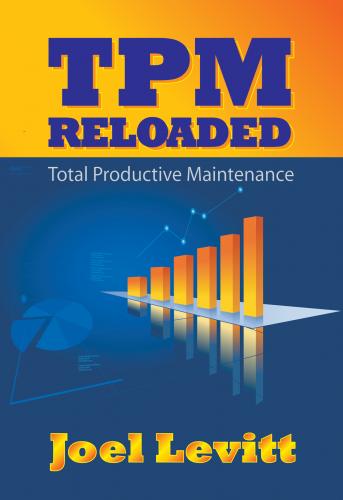TPM Has Two Aspects
Autonomous Maintenance Concept (Jishu Hozen)
Pillars and Plinths of TPM
Chapter 4 TPM Basics
The Intention of TPM Is Engagement
TPM: The Basic Idea
TPM Is a TEAM-Based Activity
Chapter 5 Maintenance
Maintenance
The Basic Activity of TPM Is PM
PM Is…
Inspection
TLC
Additional Tasks
One Way PMs are Built: Team Exercise
Chapter 6 OEE (Overall Equipment Effectiveness)
Measuring Equipment Effectiveness Is an Essential Part of TPM
OEE for a Donut Shop
Different OEE Models
Let the Confusion Begin
Examples of OEE
Chapter 7 TPM Activities
Return It to Like-New Condition
Mini-Manual for Operators
Tasks (Getting Down to the Nitty-Gritty)
Team Meetings
RCA (Root Cause Analysis) for Operators
Lean Maintenance: Is TPM Lean? TPM is Lean!
Chapter 8 Facts of Life
What Are We Trying to Do?
One Problem However — Past Sins
Three Life Cycle Phases of Equipment
Chapter 9 CMMS (Computerized Maintenance Management System)
MRP II Interface
The CMMS Work Order
Work Order Training Program for TPM Operator
Chapter 10 Visual Work Place
Gantt and His Charts
Benefits
Examples
When Is Too Much Too Much?
Chapter 11 TPM Installation
Successful TPM Installations
Imants BVBA’s Approach
Seven Steps to Reach Full Autonomous Maintenance
Key Concepts for the TPM Installation
Look Out: Problems Ahead! Why Do Half of All TPM Installations Fail?
Chapter 12 Training
For TPM to Work, You Better Be Great at Training!
Effective Training
Certified Operator and Certified Mechanic Training
Chapter 13 Structures to Keep TPM Going (Sustainability)
Keeping TPM on Track
Potential Failure of the Checklist System
Chapter 14 Is TPM for You?
How to Decide that TPM Is for You
TPM Feasibility Study
Appendices
Bibliography and Resources
Glossary
Examples of In-Depth Training
Index
Conventions:
While TPM was born in the manufacture of automobiles, elements can be applied to any productive effort. The concepts apply to a bus driver (as the operator), to a control room operator aboard a ship, or in a refinery.
This book is designed for managers and supervisors of operations and production in whatever form. That includes not only traditional manufacturing and assembly, but also mining, refining, smelting, and chemical production as well as service industries such as trucking and facility maintenance. Frequently I use the words operations and production interchangeably. In all cases, I mean both.
I don’t want to make anyone angry. But I have some things to say about our productive efforts that might be shocking or rude. This is not personal. The commentaries might not even be true for your organization. If that is the case, please sit back and enjoy the discussion about how others miss opportunities and make mistakes. Of course, maybe a little of the discussion might be true for your organization.
Part of the problem was written almost 500 years ago: “Small problems are difficult to see but easy to fix. However, when you let these problems develop, they are easy to see but very difficult to fix.” Machiavelli, Principe (1530)
Another part of the problem is complacency. The techniques we use to produce useful outcomes — such as product production, transportation, or processes — are not perfect. Many developed organically without a master plan or even a road map. Some of them are not even good; the most we can say is that they kind of work. We have to awaken to the challenge (to quote the 14 points of W. E. Deming).
At its very core, TPM shouts wake up! The era of workers dulled into sleeping zombie-like automatons is over. The era of insulated and insular management is over. Now even the most modest line workers have to solve problems, go outside their comfort zones, do maintenance tasks, and work to eliminate waste. Even the most stalwart unions have to break from their own past and embrace the idea that the enemy is in the marketplace, not in the executive suite.
Every manager has to use all the capabilities of all their people to reduce waste, improve reliability and quality, and improve safety. The people to solve problems and be mind workers have been downsized, liquidated or will be soon. What we’re left with are the workers, a few managers, and fewer staff positions.
Of course, operators are busy. Everyone in the company is busy. The issue is what is the highest value-added activity they can be doing? In many cases, the highest value-added activity is TPM activity. The same issue can be said for downtime. In some cases, additional downtime has a high return on investment such as when it reduces emergency downtime of an equal or greater duration.
Let’s face it: the name TPM confused everyone (me too). What a great idea — let’s work hard to make maintenance more productive. Logically everyone wants maintenance that is totally productive. Raise your hand if you want partially productive maintenance!
In a Japanese auto assembly plant, the name makes complete sense. Maintenance is done mostly on the line by contractors (big jobs) or line workers (small jobs). They have only a small maintenance department. In the western world, with actual maintenance departments and sometimes with union rules forbidding operators from using tools to make repairs, the name means something entirely different. If we could go back in time, we might have named it ODI (Operator Driven Improvement), ODR (Operator
